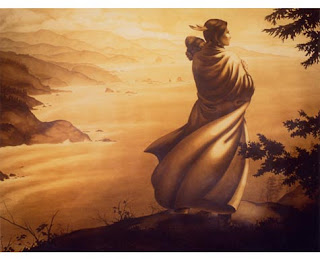From The Spirit of Sacagawea
Shoshone interpreter, member of the Lewis and Clark expedition. Born around 1788. Much about Sacagawea, the only woman on the Lewis and Clark expedition into the American West, is a mystery. Daughter of a Shoshone chief, it is not known exactly when she was born. Some sources say 1788 while others say 1787 and 1786. Around the age of 12, Sacagawea was captured by Hidatsa Indians, an enemy of the Shoshones. She was then sold to a French-Canadian trapper named Toussaint Charbonneau who made her one of his wives.
Sacagawea and her husband lived among the Hidatsa and Mandan Indians in the upper Missouri River area (present-day North Dakota). In November 1804, an expedition led by Meriwether Lewis and William Clark entered the area. Often called the Corps of Discovery, the expedition planned to explore newly acquired western lands and find a route to the Pacific Ocean. The group built Fort Mandan, and elected to stay there for the winter. Lewis and Clark met Charbonneau and quickly hired him to serve as interpreter on their expedition. Even though she was pregnant with her first child, Sacagawea was chosen to accompany them on their mission. Lewis and Clark believed that her knowledge of the Shoshone language would help them later in their journey.
n February 1805, Sacagawea gave birth to a son named Jean Baptiste Charbonneau. Despite traveling with a newborn child during the trek, Sacagawea proved to be helpful in many ways. She was skilled at finding edible plants. When a boat she was riding on capsized, she was able to save some of its cargo, including important documents and supplies. She also served as a symbol of peace — a group traveling with a woman and a child were treated with less suspicion than a group of men alone.
n February 1805, Sacagawea gave birth to a son named Jean Baptiste Charbonneau. Despite traveling with a newborn child during the trek, Sacagawea proved to be helpful in many ways. She was skilled at finding edible plants. When a boat she was riding on capsized, she was able to save some of its cargo, including important documents and supplies. She also served as a symbol of peace — a group traveling with a woman and a child were treated with less suspicion than a group of men alone.
Sacagawea also made a miraculous discovery of her own during the trip west. When the corps encountered a group of Shoshone Indians, she soon realized that its leader was actually her brother Cameahwait. It was through her that the expedition was able to buy horses from the Shoshone to cross the Rocky Mountains. Despite this joyous family reunion, Sacagawea remained with the explorers for the trip west.
After reaching the Pacific coast in November 1805, Sacagawea was allowed to cast her vote along with the other members of the expedition for where they would build a fort to stay for the winter. They built Fort Clatsop near present-day Astoria, Oregon, and they remained there until March of the following year. Sacagawea, her husband, and her son remained with the expedition on the return trip east until they reached the Mandan villages. During the journey, Clark had become fond of her son Jean Baptiste, nicknaming him "Pomp" or "Pompey." And he even offered to help him get an education.
Once Sacagawea left the expedition, the details of her life become more elusive. In 1809, it is believed that she and her husband — or just her husband according to some accounts — traveled with their son to St. Louis to see Clark. Pomp was left in Clark's care. Sacagawea gave birth to her second child, a daughter named Lisette, three years later. Only a few months after her daughter's arrival, she reportedly died at Fort Manuel in what is now South Dakota in 1812. (There were stories that it was another wife of Charbonneau who died at Fort Manuel, but historians don t give much credence to this.) After Sacagawea's death, Clark looked after her two children, and ultimately took custody of them both.
Over the years, tributes to Sacagawea and her contribution to the Corps of Discovery have come in many forms, such as statues, place-names, and she was even featured on a dollar coin issued in 2000 by the U.S. Mint.
© 2011 A&E Television Networks. All rights reserved.
More at:http://www.pbs.org/weta/thewest/people/s_z/sacagawea.htm




No comments:
Post a Comment